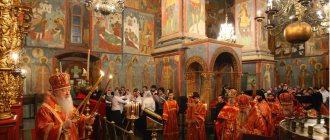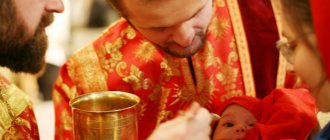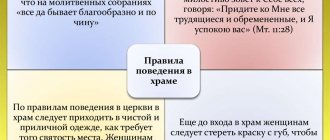What time does the early and late morning service in church begin and end?
Important: each temple creates its own schedule of public services! There is no general schedule for all temples!
Two liturgies, early and late, are served on major Christian holidays and Sundays in churches with large parishes.
The early service is held at 6-7 a.m., the late service at 9-10 a.m. In some churches, the time is shifted to 7-8 a.m. for early services and 10-11 a.m. for late ones.
The duration of public worship is 1.5-2 hours. In some cases, the duration of the morning liturgy can be 3 hours.
Recommendations
- BBC, Christian Worship, bbc.co.uk, UK, 23 June 2009.
- Geoffrey Wainwright, The Oxford History of Christian Worship
, Oxford University Press, USA, 2006, p. 465 - Amy-Jill Levine, Dale Ellison Jr., John Dominic Crossan, The Historical Jesus in Context
, Princeton University Press, USA, 2009, p. 2 - Mark 14.26, Matthew 26.30; see John J. Pilch, A Cultural Sourcebook of the Bible, Wm. B. Eerdmans Publishing, USA, 2012, p. 263
- Pliny the Younger, Epistulae
, Book X, Letter xcvii. - Don Kuzik, Encyclopedia of Contemporary Christian Music: Pop, Rock and Worship: Pop, Rock and Worship
, ABC-CLIO, USA, 2009, p. 79 - Suzel Ana Reilly, Jonathan M. Duque, The Oxford Handbook of Music and World Christianity
, Oxford University Press, USA, 2016, p. 443 - Matthew Guest, Evangelical Identity and Modern Culture: A Congregational Study of Innovation
, Wipf and Stock Publishers, USA, 2007, p. 42 - Don Kuzik, Encyclopedia of Contemporary Christian Music: Pop, Rock and Worship: Pop, Rock and Worship
, ABC-CLIO, USA, 2009, pp. 85-86 - Monique M. Ingalls, Singing Community: How Contemporary Worship Music Shapes Evangelical Community
, Oxford University Press, USA, 2022, p. 7 - William H. Brackney, Baptist Historical Dictionary
, Scarecrow Press, USA, 2009, p. 403 - William J. Collinge, Historical Dictionary of Catholicism
, Scarecrow Press, USA, 2012, p. 280 - J. Gordon Melton, Encyclopedia of Protestantism
, Infobase Publishing, USA, 2005, p. 345 - Helmut Berking, Silke Stets, Jochen Schwenk, Religious Pluralism and the City: Studies in Post-Secular Urbanism
, Bloomsbury Publishing, UK, 2022, p. 78 - George Thomas Kurian, Mark A. Lamport, Encyclopedia of Christianity in the USA, Volume 5
, Rowman and Littlefield, USA, 2016, p. 1359 - George Thomas Kurian, Mark A. Lamport, Encyclopedia of Christianity in the USA, Volume 5
, Rowman and Littlefield, USA, 2016, pp. 2275-2276 - Michael Gryboski, Millennial Churches Detail Challenges, Growth and Financial Success Stories, christianpost.com, USA, June 18, 2022.
- Ghana News Agency, Asoriba launches church management software, businessghana.com, Ghana, February 3, 2022.
- George Thomas Kurian, Mark A. Lamport, Encyclopedia of Christian Education, Volume 3
, Rowman and Littlefield, USA, 2015, p. 229 - Jeanne Halgren Kilde, When Church Became Theater: The Transformation of Evangelical Architecture and Worship in Nineteenth-Century America
, Oxford University Press, USA, 2005, pp. 159, 170, 188 - Greg Dickinson, Suburban Dreams: Imagining and Creating the Good Life
, University of Alabama Press, USA, 2015, p. 144
What time does the evening and night service in the church begin and end?
Evening public worship is served no earlier than 16:00 and no later than 18:00. Each temple has its own schedule.
The duration of the service is 2-4 hours and depends on the significance of the upcoming holiday. According to the Rule, Vespers can be daily, small and great.
Every day is performed on weekdays, unless a holiday with a polyeleos or vigil falls on them.
Malaya is part of the All-Night Vigil. The Great Service is served on major holidays and can be performed separately or combined with Matins.
The world is changing, and these changes affect, among other things, the Church Charter. Night or all-night vigils rarely last from three to six hours (for monasteries). In ordinary churches, the duration of the night service is 2-4 hours.
The night service begins at 17:00-18:00 depending on the parish Charter.
What time does Saturday church service begin and end?
Having carefully read the previous part of the article, you most likely noticed the fact that the beginning of the liturgical day corresponds not to 00:00 (as is customary in secular life), but to 18:00 (the previous calendar day).
What does it mean?
This means that the first Saturday service begins on Friday after 18:00, and the last service ends on Saturday before 18:00. The most important Saturday service is the full Divine Liturgy.
As a rule, Saturday services are dedicated to the venerable fathers and mothers, as well as to all the saints, to whom they turn with appropriate prayers. On the same day, the commemoration of all the dead takes place.
Check with the temple you are planning to visit for the exact schedule of services.
Liturgy of the Catechumens
A catechumen is a person who undergoes the catechumen - preparation for the Sacrament of baptism, during which he learns the basics of the Christian faith. Nowadays, people are most often baptized in infancy, so the question of announcement is not raised, but the name of the second part of the liturgy has been preserved. Everyone is allowed to attend this part of the liturgy - both baptized and unbaptized.
“Bless, lord!” - exclaims the deacon. In response, the priest, still in the altar, pronounces words glorifying the Holy Trinity, which the choir ends with the word “Amen”.
The priest prays in the altar, the deacon calls on those gathered: “Let us pray to the Lord in peace.” He then pronounces the great litany, which lists the various petitions to God.
The choir sings psalms and hymns, after which the royal doors open, and the priest and deacon leave the altar through the northern entrance, bringing out the Holy Gospel. This is called a "small entrance".
The choir sings a few prayers, then the priest exclaims: “Let us hear!” (let’s listen), and the reading of a fragment from the “Acts of the Apostles” begins. At this time, the priest walks around the temple, censing. Then the choir sings: “Hallelujah!”, and the central moment of the Liturgy of the Catechumens begins - the reading of a fragment from the Gospel.
The reading is followed by a prayer for living and dead Christians.
The Liturgy of the Catechumens ends with the priest’s call: “Catechumens, come forth!”
What time does the festive service in the church begin and end: schedule
You can find approximate times for morning and evening services at the beginning of the article.
Each temple draws up its own schedule of public services, including holiday ones. There is no general schedule for all temples!
As a rule, the Charter prescribes the so-called “all-night vigil” to be served on holidays - a particularly solemn service, which in modern interpretation has retained the division into Vespers and Matins.
In addition, on the days of the twelfths and other major holidays, the Liturgy necessarily takes place, during which believers receive communion.
At the same time, each holiday service has accompanying texts and rituals unique to it, which cannot but affect the duration of the service.
What time does the Christmas service in church begin and end?
Christmas service in the Cathedral of Christ the Savior
The pre-holiday service begins early in the morning on January 6th.
- 1st hour service. Time - from 7:00. Stichera are read about the fulfillment of the prophecy about the birth of the Messiah.
- 3rd hour service. Time - from 9:00. The stichera about the Incarnation are read.
- 6th hour service. Time - from 12:00. The stichera with the call to meet Christ are read, and the Gospel is read.
- 9 o'clock service. Time - from 15:00. Stichera are read. At the end they read figuratively.
Holiday service (January 6)
- Depending on the day on which Christmas Eve falls, one of the evening Liturgies is celebrated: St. Basil the Great or St. John Chrysostom. Time: depending on the temple from 17:00.
- Celebration of the Great Vespers of the Nativity of Christ.
- Celebration of the All-Night Vigil of the Nativity of Christ. Time: depending on the temple - from 17:00 to 23:00.
There is no strict sequence in conducting the festive service. In large churches and monasteries, Christmas services (evening, the most solemn part) last 6-8 hours, in small ones - 1.5-2 hours.
Find out about the exact time of the service at the temple you are going to visit.
You can read about the folk traditions of celebrating Christmas here.
Basics of Orthodoxy. About the services performed in the temple
Public worship, or, as people say, church services, is the main thing for which our churches are intended. Every day the Orthodox Church holds evening, morning and afternoon services in churches. Each of these services consists in turn of three types of services, collectively combined into a daily cycle of services:
vespers - from the 9th hour, vespers and compline;
morning - from midnight office, matins and 1st hour;
daytime - from the 3rd hour, 6th hour and Divine Liturgy.
Thus, the entire daily circle consists of nine services.
In Orthodox worship, much is borrowed from the worship of Old Testament times. For example, the beginning of a new day is considered not midnight, but six o’clock in the evening. That is why the first service of the daily cycle is Vespers.
At Vespers, the Church remembers the main events of the sacred history of the Old Testament: the creation of the world by God, the fall of the first parents, the Mosaic legislation and the ministry of the prophets. Christians give thanks to the Lord for the day they have lived.
After Vespers, according to the Church Rules, Compline is supposed to be served. In a certain sense, these are public prayers for the sleep of the future, in which the descent of Christ into hell and the liberation of the righteous from the power of the devil are remembered.
At midnight, the third service of the daily cycle is supposed to be performed - the Midnight Office. This service was established to remind Christians of the Second Coming of the Savior and the Last Judgment.
Before sunrise, Matins is served - one of the longest services. It is dedicated to the events of the earthly life of the Savior and contains many prayers of both repentance and gratitude.
At about seven o'clock in the morning they perform the 1st hour. This is the name of the short service at which the Orthodox Church remembers the presence of Jesus Christ at the trial of the high priest Caiaphas.
The 3rd hour (nine o’clock in the morning) is served in remembrance of the events that took place in the Upper Room of Zion, where the Holy Spirit descended on the Apostles, and in Pilate’s Praetorium, where the Savior was sentenced to death.
The 6th hour (noon) is the time of the Lord’s crucifixion, and the 9th hour (three o’clock in the afternoon) is the time of His death on the cross. The above-mentioned services are dedicated to these events.
The main divine service of the Orthodox Church, a kind of center of the daily circle, is the Divine Liturgy. Unlike other services, the liturgy provides an opportunity not only to remember God and the entire earthly life of the Savior, but also to actually unite with Him in the sacrament of Communion, established by the Lord Himself during the Last Supper. According to the time, the liturgy should be performed between the 6th and 9th hour, before noon, in the pre-dinner time, which is why it is also called mass.
Modern liturgical practice has brought its own changes to the regulations of the Charter. Thus, in parish churches, Compline is celebrated only during Lent, and the Midnight Office is celebrated once a year, on the eve of Easter. The 9th hour is extremely rarely served. The remaining six services of the daily circle are combined into two groups of three services.
In the evening, Vespers, Matins and the 1st hour are performed in succession. On the eve of Sundays and holidays, these services are combined into one service called the all-night vigil. In ancient times, Christians actually often prayed until dawn, that is, they stayed awake throughout the night. Modern all-night vigils last two to four hours in parishes and three to six hours in monasteries.
In the morning, the 3rd hour, the 6th hour and the Divine Liturgy are served successively. In churches with large congregations, there are two liturgies on Sundays and holidays - early and late. Both are preceded by reading the hours.
On those days when there is no liturgy (for example, on Friday of Holy Week), a short sequence of visual services is performed. This service consists of some chants of the liturgy and, as it were, “depicts” it. But the visual arts do not have the status of an independent service.
Divine services also include the performance of all sacraments, rituals, reading of akathists in church, community readings of morning and evening prayers, rules for Holy Communion.
In addition to daily church services (such as Matins, or Vespers, or the Hours), services are also performed according to the needs of Christians, that is, requirements. For example: Baptism, Wedding, Unction, prayer services, funeral services and others.
Divine services are usually performed in church and only by clergy, while believers participate in them through prayer and singing.
What time does the service in the church on Epiphany Eve begin and end?
Services on Epiphany Eve are very similar to Christmas services.
The date of Epiphany Eve is January 18.
On this day, the hours are read in the morning, and in the evening the Liturgy of St. Basil the Great is celebrated. After the Liturgy, as a rule, the first blessing of water occurs.
Depending on the day on which Epiphany falls, the order of services may differ.
On January 19, morning and evening services are held with the obligatory subsequent blessing of water.
The exact time of the services will be told to you directly in the temple.
You can read about the properties of Epiphany water by following the link.
What time does the festive service in the church for the Annunciation begin and end?
Congratulations on the Annunciation
The Annunciation is celebrated on April 7. However, believers should attend the evening service on April 6. In some churches, all-night vigils are held from April 6 to 7.
On April 7, early and/or late liturgies are served with mandatory confession and communion for the laity.
The time of services depends on the internal regulations of the temple.
What time does the festive service in church on Palm Sunday begin and end?
The date of Palm Sunday celebration depends on the date of Easter celebration and is determined according to the lunisolar calendar.
Festive services begin with the evening service and subsequent all-night vigils on Lazarus Saturday. Lazarus Saturday is the day before Palm Sunday. During the evening service, palm branches are necessarily blessed.
On Palm Sunday, early and/or late liturgies are performed, followed by the consecration of the willow tree.
The time of services depends on the internal regulations of the temple.
What time does the festive service in church on Easter begin and end?
Everything depends on the internal regulations of the temple. Be sure to check the time of services!
As a rule, holiday services begin on Saturday with an evening service (16:00-18:00). In some churches, after the evening service, a blessing of Easter cakes is held.
Then all-night vigils begin with a mandatory religious procession at 24:00.
After vigils and matins, the Divine Liturgy is served, followed by the blessing of Easter cakes. As a rule, the blessing occurs at the first rays of the sun.
In the evening of the Bright Resurrection of Christ, an evening service is celebrated. However, Easter cakes are no longer blessed.
Beautiful Easter greetings can be found at the link.
Liturgy takes place in every church
The Divine Liturgy is the central service, since during it the Sacrament of the Eucharist and the Sacrament occur (or rather, the Liturgy itself accompanies these Sacraments). All other services in one way or another precede the Liturgy - although they can take place the night before or even earlier.
photo: patriarchia.ru
What time does the festive service in the church on Radonitsa begin and end?
The meaning of the holiday Radonitsa
Radonitsa is a special holiday that connects the past and the future. On this day it is customary to remember deceased relatives and friends.
Radonitsa is celebrated on the ninth day after Easter Sunday.
The evening before, an evening service is held, and in the morning there is an early and/or late liturgy. A full memorial service is served either after the evening service or after the morning services - it all depends on the internal rules of the temple.
In addition, the charters of many churches require that Easter funeral services be held in city cemeteries.
Be sure to check the time of services directly with the temple you want to visit!
More information about Radonitsa here.
What is the Six Psalms after Matins?
Reading the Old Testament psalms shows the sorrow of the human soul over its fallen sinful state, languor in anticipation of the coming of the Savior, which filled the times of the Old Testament.
Interesting! To ensure that the reading of the Six Psalms is not too gloomy, the mood of the psalms changes: both mournful psalms and joyful psalms filled with the Glory of the coming of Christ are read.
A special attitude towards the Six Psalms is expressed in the fact that during this reading all those praying are supposed to stand, but walking around the temple, lighting candles, or performing any other actions is forbidden. Of course, if a person, due to his weakness, cannot withstand this part of the service, he can sit down.
The Six Psalms are read at every morning, with the exception of the days of Bright Week.
The Six Psalms are read in two parts: after the first three psalms, the priest stands in front of the Royal Doors and begins reading special morning prayers, in which he asks for blessings for himself and his flock for the new day, and thanks for the past night. Coming out of the altar, the priest symbolically personifies Christ as the promised Savior of all mankind.
Read about the services:
- Divine service for Christmas
- Why should you go to temple?
- What is a prayer service and how to order it
What time does the festive service in the church for Trinity begin and end?
The date of the celebration of Trinity or Pentecost depends on the date of Bright Resurrection.
Important: on the eve of the holiday of Trinity, Trinity Parents' Saturday is always held, the peculiarity of which is a special funeral service. This is a special Funeral Liturgy, after which you can and should visit the cemetery and remember the dead.
The evening of Parents' Saturday is marked by a festive All-Night Vigil.
On Sunday, early and/or late holiday liturgies are celebrated. In many temples, bouquets of twigs and medicinal herbs are blessed.
Be sure to check the time of services directly with the temple you want to visit!
Tips on how to talk to children about the Trinity at the link.
The Orthodox calendar 2022 will help you not to miss significant services.
Three Circles of Worship
that has developed since the first centuries of the Church , that is, the order of performing services, consists of three large cycles, or “circles.”
Daily
It was finally established in the 11th century. A day is traditionally counted from the evening of the previous day. This is connected with the story of the Book of Genesis from the creation of the world: after all, according to it, the day of creation began in the evening, and was described as follows: “And there was evening, and there was morning...” (Gen. 1:5), that is, the beginning of the day was evening.
Weekly
Here, in comparison with the civil calendar, there are also some peculiarities: the first day of the week has long been considered Sunday, not Monday. Even the name of this day suggests that it is not the first, but follows “by the week,” that is, after Sunday.
Scheme of the daily liturgical circle
Each day of the week is dedicated to a saint, sometimes to a holiday. In addition to this, however, there are certain days when they especially pray, remembering:
- Angelov (Monday); The day is especially revered by monastics, for, according to the word of St. fathers, “angels are the light of monks”;
- St. John the Baptist (Tuesday);
- betrayal of Judas (Wednesday);
- St. Nicholas (Thursday);
- Crucifixion (Friday);
- deceased relatives (Saturday).
Annual
In turn, this liturgical circle is divided into:
- “fixed”, that is, consisting of holidays with a specific date;
- “movable”, which includes church celebrations, the times of which change from year to year. These include Easter , the time of which determines the beginning of Great Lent , the weeks of preparation for it, the holidays of the Ascension and Pentecost.
The annual circle of church services. Scheme










